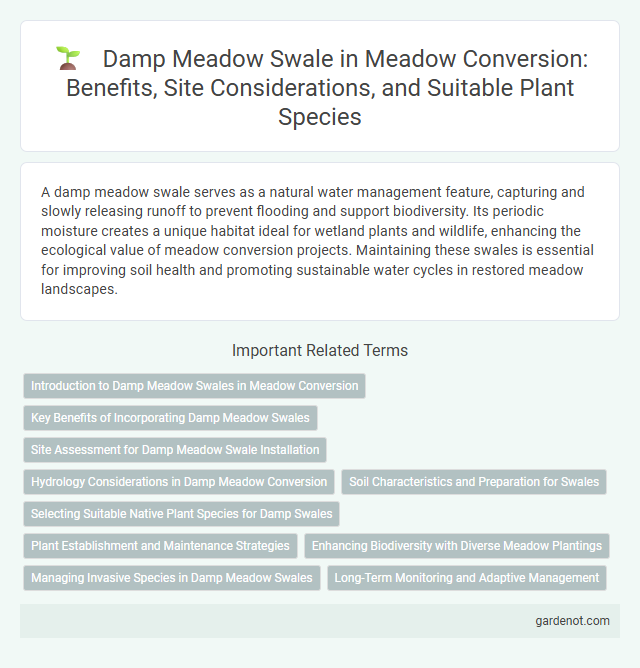A damp meadow swale serves as a natural water management feature, capturing and slowly releasing runoff to prevent flooding and support biodiversity. Its periodic moisture creates a unique habitat ideal for wetland plants and wildlife, enhancing the ecological value of meadow conversion projects. Maintaining these swales is essential for improving soil health and promoting sustainable water cycles in restored meadow landscapes.
Introduction to Damp Meadow Swales in Meadow Conversion
Damp meadow swales are shallow, vegetated channels designed to manage and enhance water retention in meadow conversion projects. These swales mimic natural hydrological patterns by slowing runoff, increasing infiltration, and supporting diverse wetland plant species. Incorporating damp meadow swales improves soil moisture balance, promotes biodiversity, and reduces erosion in restored meadow ecosystems.
Key Benefits of Incorporating Damp Meadow Swales
Damp meadow swales enhance stormwater management by effectively capturing and filtering runoff, reducing flood risks and improving water quality. These natural depressions create diverse wetland habitats that support a wide range of plant and animal species, boosting local biodiversity. Incorporating damp meadow swales also aids in groundwater recharge and soil moisture retention, promoting sustainable landscape resilience.
Site Assessment for Damp Meadow Swale Installation
Site assessment for damp meadow swale installation involves evaluating soil permeability, hydrology, and existing vegetation to ensure effective water retention and filtration. Detailed topographic surveys identify low-lying areas suitable for swale placement, optimizing natural drainage patterns. Soil testing confirms moisture levels and compaction, guiding the design to enhance habitat diversity and flood mitigation benefits.
Hydrology Considerations in Damp Meadow Conversion
Damp meadow swales play a critical role in hydrology during meadow conversion by facilitating natural water retention and slow runoff. Their design enhances groundwater recharge and supports diverse wetland flora, maintaining ecological balance. Proper management of soil permeability and gradient ensures effective water filtration and prevents erosion in damp meadow restoration projects.
Soil Characteristics and Preparation for Swales
Damp meadow swales require soil with high organic matter content and excellent water retention capabilities to effectively manage runoff and support native vegetation. Preparing the soil involves grading the area to promote slow water infiltration and incorporating amendments like compost to improve soil structure and nutrient availability. Proper soil compaction techniques ensure stability while maintaining porosity essential for swale functionality and plant health.
Selecting Suitable Native Plant Species for Damp Swales
Selecting suitable native plant species for damp meadow swales enhances ecological stability and water filtration. Species such as Carex stricta, Juncus effusus, and Scirpus cyperinus thrive in periodically saturated soils, supporting biodiversity and preventing erosion. Incorporating a diverse mix of native sedges, rushes, and wildflowers ensures sustained habitat quality and hydrological function.
Plant Establishment and Maintenance Strategies
Damp meadow swale plant establishment requires selecting native species such as Carex spp., Juncus effusus, and Glyceria maxima known for tolerance to saturated soils and periodic inundation. Maintenance strategies include regular monitoring for invasive species, seasonal mowing to prevent woody plant encroachment, and supplemental watering during dry spells to ensure successful germination and root development. Soil moisture retention and nutrient cycling are enhanced by organic mulching and minimal soil disturbance to support long-term vegetation stability.
Enhancing Biodiversity with Diverse Meadow Plantings
Damp meadow swales serve as crucial habitats by supporting a wide variety of moisture-tolerant native plants, which foster a rich ecosystem for pollinators and amphibians. Incorporating diverse meadow plantings, including sedges, rushes, and wildflowers, enhances soil health and water retention, promoting ecological resilience. This biodiversity not only stabilizes wetland areas but also increases habitat connectivity for local wildlife, aiding conservation efforts in meadow conversions.
Managing Invasive Species in Damp Meadow Swales
Managing invasive species in damp meadow swales requires targeted removal techniques such as manual pulling and selective herbicide application to preserve native biodiversity. Regular monitoring and early detection are critical to prevent the establishment of aggressive species like reed canary grass and purple loosestrife. Restoring native vegetation through reseeding and hydrological adjustments supports long-term ecosystem resilience and habitat quality.
Long-Term Monitoring and Adaptive Management
Long-term monitoring of damp meadow swales ensures the early detection of hydrological changes and vegetation shifts critical for maintaining ecosystem health. Adaptive management strategies utilize continuous data collection to adjust water flow, plant species composition, and habitat restoration efforts for optimal biodiversity support. Implementing these practices enhances the resilience and functionality of meadow swale systems under varying environmental conditions.
Damp meadow swale, Infographic

 gardenot.com
gardenot.com